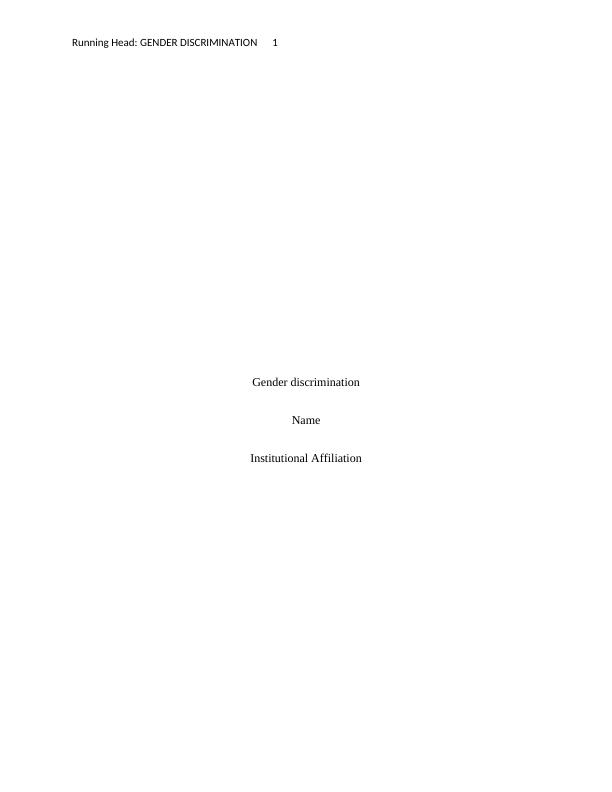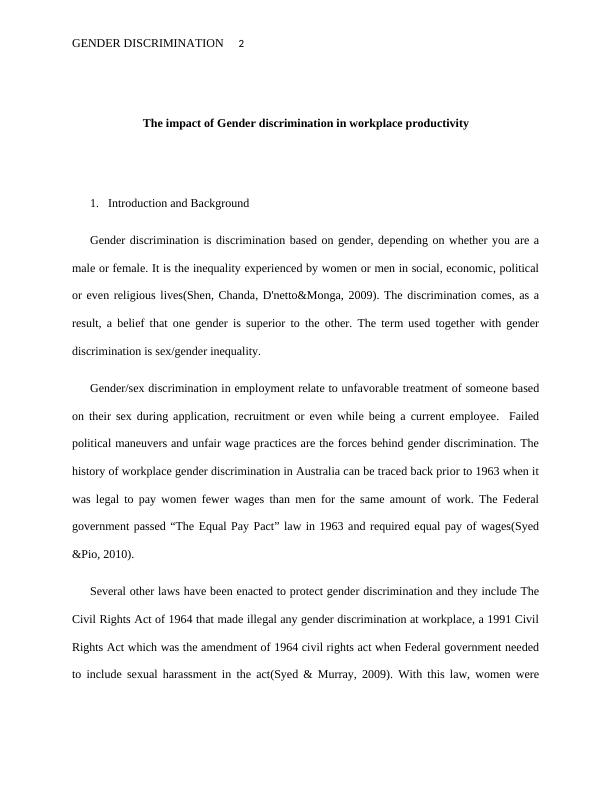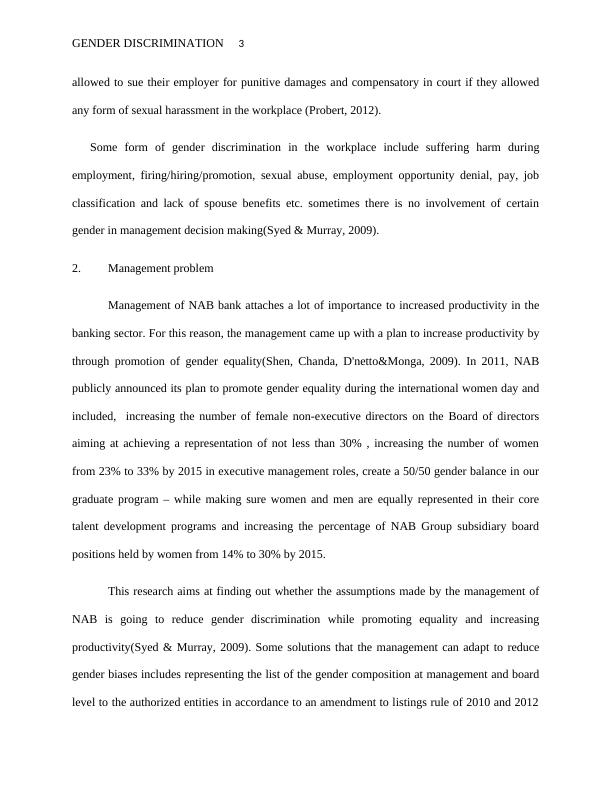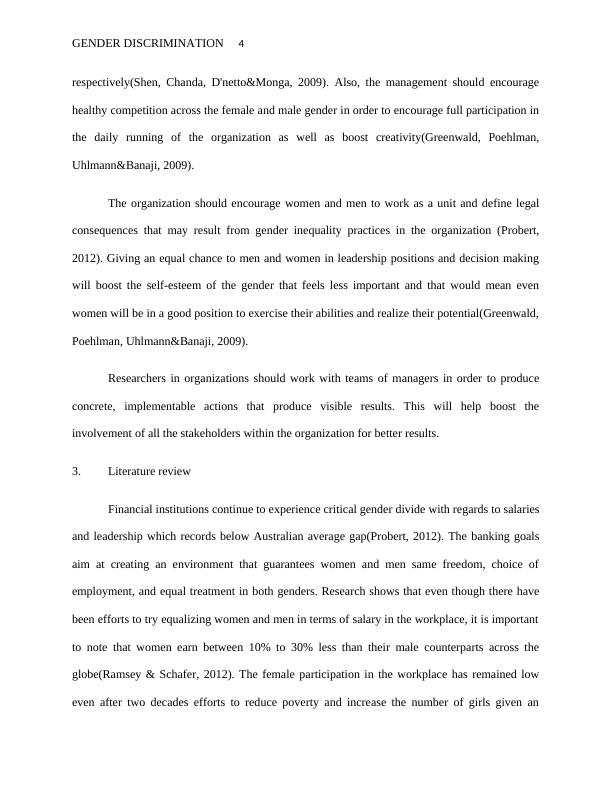The Impact of Gender Discrimination on Workplace Productivity
Added on 2023-06-11
15 Pages3649 Words159 Views
Running Head: GENDER DISCRIMINATION 1
Gender discrimination
Name
Institutional Affiliation
Gender discrimination
Name
Institutional Affiliation

GENDER DISCRIMINATION 2
The impact of Gender discrimination in workplace productivity
1. Introduction and Background
Gender discrimination is discrimination based on gender, depending on whether you are a
male or female. It is the inequality experienced by women or men in social, economic, political
or even religious lives(Shen, Chanda, D'netto&Monga, 2009). The discrimination comes, as a
result, a belief that one gender is superior to the other. The term used together with gender
discrimination is sex/gender inequality.
Gender/sex discrimination in employment relate to unfavorable treatment of someone based
on their sex during application, recruitment or even while being a current employee. Failed
political maneuvers and unfair wage practices are the forces behind gender discrimination. The
history of workplace gender discrimination in Australia can be traced back prior to 1963 when it
was legal to pay women fewer wages than men for the same amount of work. The Federal
government passed “The Equal Pay Pact” law in 1963 and required equal pay of wages(Syed
&Pio, 2010).
Several other laws have been enacted to protect gender discrimination and they include The
Civil Rights Act of 1964 that made illegal any gender discrimination at workplace, a 1991 Civil
Rights Act which was the amendment of 1964 civil rights act when Federal government needed
to include sexual harassment in the act(Syed & Murray, 2009). With this law, women were
The impact of Gender discrimination in workplace productivity
1. Introduction and Background
Gender discrimination is discrimination based on gender, depending on whether you are a
male or female. It is the inequality experienced by women or men in social, economic, political
or even religious lives(Shen, Chanda, D'netto&Monga, 2009). The discrimination comes, as a
result, a belief that one gender is superior to the other. The term used together with gender
discrimination is sex/gender inequality.
Gender/sex discrimination in employment relate to unfavorable treatment of someone based
on their sex during application, recruitment or even while being a current employee. Failed
political maneuvers and unfair wage practices are the forces behind gender discrimination. The
history of workplace gender discrimination in Australia can be traced back prior to 1963 when it
was legal to pay women fewer wages than men for the same amount of work. The Federal
government passed “The Equal Pay Pact” law in 1963 and required equal pay of wages(Syed
&Pio, 2010).
Several other laws have been enacted to protect gender discrimination and they include The
Civil Rights Act of 1964 that made illegal any gender discrimination at workplace, a 1991 Civil
Rights Act which was the amendment of 1964 civil rights act when Federal government needed
to include sexual harassment in the act(Syed & Murray, 2009). With this law, women were

GENDER DISCRIMINATION 3
allowed to sue their employer for punitive damages and compensatory in court if they allowed
any form of sexual harassment in the workplace (Probert, 2012).
Some form of gender discrimination in the workplace include suffering harm during
employment, firing/hiring/promotion, sexual abuse, employment opportunity denial, pay, job
classification and lack of spouse benefits etc. sometimes there is no involvement of certain
gender in management decision making(Syed & Murray, 2009).
2. Management problem
Management of NAB bank attaches a lot of importance to increased productivity in the
banking sector. For this reason, the management came up with a plan to increase productivity by
through promotion of gender equality(Shen, Chanda, D'netto&Monga, 2009). In 2011, NAB
publicly announced its plan to promote gender equality during the international women day and
included, increasing the number of female non-executive directors on the Board of directors
aiming at achieving a representation of not less than 30% , increasing the number of women
from 23% to 33% by 2015 in executive management roles, create a 50/50 gender balance in our
graduate program – while making sure women and men are equally represented in their core
talent development programs and increasing the percentage of NAB Group subsidiary board
positions held by women from 14% to 30% by 2015.
This research aims at finding out whether the assumptions made by the management of
NAB is going to reduce gender discrimination while promoting equality and increasing
productivity(Syed & Murray, 2009). Some solutions that the management can adapt to reduce
gender biases includes representing the list of the gender composition at management and board
level to the authorized entities in accordance to an amendment to listings rule of 2010 and 2012
allowed to sue their employer for punitive damages and compensatory in court if they allowed
any form of sexual harassment in the workplace (Probert, 2012).
Some form of gender discrimination in the workplace include suffering harm during
employment, firing/hiring/promotion, sexual abuse, employment opportunity denial, pay, job
classification and lack of spouse benefits etc. sometimes there is no involvement of certain
gender in management decision making(Syed & Murray, 2009).
2. Management problem
Management of NAB bank attaches a lot of importance to increased productivity in the
banking sector. For this reason, the management came up with a plan to increase productivity by
through promotion of gender equality(Shen, Chanda, D'netto&Monga, 2009). In 2011, NAB
publicly announced its plan to promote gender equality during the international women day and
included, increasing the number of female non-executive directors on the Board of directors
aiming at achieving a representation of not less than 30% , increasing the number of women
from 23% to 33% by 2015 in executive management roles, create a 50/50 gender balance in our
graduate program – while making sure women and men are equally represented in their core
talent development programs and increasing the percentage of NAB Group subsidiary board
positions held by women from 14% to 30% by 2015.
This research aims at finding out whether the assumptions made by the management of
NAB is going to reduce gender discrimination while promoting equality and increasing
productivity(Syed & Murray, 2009). Some solutions that the management can adapt to reduce
gender biases includes representing the list of the gender composition at management and board
level to the authorized entities in accordance to an amendment to listings rule of 2010 and 2012

GENDER DISCRIMINATION 4
respectively(Shen, Chanda, D'netto&Monga, 2009). Also, the management should encourage
healthy competition across the female and male gender in order to encourage full participation in
the daily running of the organization as well as boost creativity(Greenwald, Poehlman,
Uhlmann&Banaji, 2009).
The organization should encourage women and men to work as a unit and define legal
consequences that may result from gender inequality practices in the organization (Probert,
2012). Giving an equal chance to men and women in leadership positions and decision making
will boost the self-esteem of the gender that feels less important and that would mean even
women will be in a good position to exercise their abilities and realize their potential(Greenwald,
Poehlman, Uhlmann&Banaji, 2009).
Researchers in organizations should work with teams of managers in order to produce
concrete, implementable actions that produce visible results. This will help boost the
involvement of all the stakeholders within the organization for better results.
3. Literature review
Financial institutions continue to experience critical gender divide with regards to salaries
and leadership which records below Australian average gap(Probert, 2012). The banking goals
aim at creating an environment that guarantees women and men same freedom, choice of
employment, and equal treatment in both genders. Research shows that even though there have
been efforts to try equalizing women and men in terms of salary in the workplace, it is important
to note that women earn between 10% to 30% less than their male counterparts across the
globe(Ramsey & Schafer, 2012). The female participation in the workplace has remained low
even after two decades efforts to reduce poverty and increase the number of girls given an
respectively(Shen, Chanda, D'netto&Monga, 2009). Also, the management should encourage
healthy competition across the female and male gender in order to encourage full participation in
the daily running of the organization as well as boost creativity(Greenwald, Poehlman,
Uhlmann&Banaji, 2009).
The organization should encourage women and men to work as a unit and define legal
consequences that may result from gender inequality practices in the organization (Probert,
2012). Giving an equal chance to men and women in leadership positions and decision making
will boost the self-esteem of the gender that feels less important and that would mean even
women will be in a good position to exercise their abilities and realize their potential(Greenwald,
Poehlman, Uhlmann&Banaji, 2009).
Researchers in organizations should work with teams of managers in order to produce
concrete, implementable actions that produce visible results. This will help boost the
involvement of all the stakeholders within the organization for better results.
3. Literature review
Financial institutions continue to experience critical gender divide with regards to salaries
and leadership which records below Australian average gap(Probert, 2012). The banking goals
aim at creating an environment that guarantees women and men same freedom, choice of
employment, and equal treatment in both genders. Research shows that even though there have
been efforts to try equalizing women and men in terms of salary in the workplace, it is important
to note that women earn between 10% to 30% less than their male counterparts across the
globe(Ramsey & Schafer, 2012). The female participation in the workplace has remained low
even after two decades efforts to reduce poverty and increase the number of girls given an

End of preview
Want to access all the pages? Upload your documents or become a member.
Related Documents
Evaluation of the Paycheck Fairness Act Legislative Processlg...
|12
|2836
|205
International Journal of Public Opinion Researchlg...
|4
|853
|61
Governance, Ethics and Sustainability | Report | Newlg...
|11
|2834
|34
Age Discrimination in Employment Actlg...
|10
|2436
|13
Gender Discrimination in Australia Analysis Of Findingslg...
|6
|2256
|91
Women and Workplace Discrimination in Australian Organizationslg...
|17
|4508
|90
